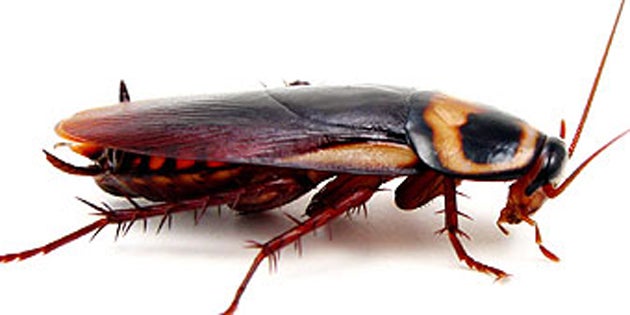Jeff Triblehorn’s research is not for the faint of heart.
An assistant professor of neurobiology in the Department of Biology at the College of Charleston, Triblehorn has spent much of his career studying bugs. Not the pretty kind like butterflies or ladybugs. Triblehorn’s research tends to focus on the more menacing ones – like praying mantises and the ubiquitous, scurrying cockroach.
What can a neurobiologist learn from bugs? As it turns out, examining the sensory systems of these invertebrates yields all sorts of interesting and useful data about how the creatures acquire information from their environments and how they process that information to respond to potential threats.
Triblehorn’s research, which often involves undergraduate students from the College’s neuroscience minor, focuses on an area of neurobiology known as neurophysiology. He measures and records the activity of specific neurons within the insects’ nervous systems in response to certain stimuli.
RELATED: Read more about the College’s neuroscience program.
The stimuli can be as benign as blowing on a cockroach to see how it reacts. Or the stimuli can be more potent: Triblehorn has studied the neurological behavior of praying mantises in response to bat attacks.
Praying Prey
As a graduate student at the University of Maryland College Park, Triblehorn worked under a mentor who discovered that praying mantises have an ear that is solely evolved for the purpose of detecting flying bats. The mantis’ ears are sensitive to the high-frequency echolocation signals emitted by bats to navigate in the dark.
 There’s just one problem with this evolutionary adaption. Though the mantis has two eardrums, both are contained within a single ear located on the center of its body. Because the eardrums are not separated by distance, the mantis can detect only that a bat is approaching, not the direction from which it is coming. “It’s the only known ear that can’t tell direction,” says Triblehorn.
There’s just one problem with this evolutionary adaption. Though the mantis has two eardrums, both are contained within a single ear located on the center of its body. Because the eardrums are not separated by distance, the mantis can detect only that a bat is approaching, not the direction from which it is coming. “It’s the only known ear that can’t tell direction,” says Triblehorn.
To test the effectiveness of this detection system, Triblehorn conducted experiments in which bats were released in a “flight room” around which mantises had been strategically positioned. The mantises were connected to wires so that the researchers could measure the presence and strength of firing auditory neurons. “Every time the bat made an echolocation signal, you would get a burst of spikes coming from the auditory neurons of the mantis,” says Triblehorn.
As part of his doctoral dissertation, Triblehorn discovered that the mantis actually has two prey-detection systems. When the researchers applied a dab of Vaseline to the mantis’ ear, leaving it temporarily deaf, the mantis employed a back-up detection system that sensed the wind produced by the flapping wings of an approaching bat.
Mantises have two prongs located at the rear of their bodies that are covered in microscopic hairs called cerci. These hairs are highly sensitive to wind. “Their auditory response will be their main response to get away from the bat, but if that fails the mantis can use a wind-detection system as a last-ditch effort to escape.”
Palmetto Bug Biology
 Studying the wind-detection systems of mantises led Triblehorn to look at cockroaches, which, like mantises, have sophisticated wind-detection systems. Unlike mantises, however, cockroaches are deaf. As a result, their ability to detect wind and substrate vibration is very acute. “They are one of the most sensitive biological sensory systems on the planet,” says Triblehorn.“
Studying the wind-detection systems of mantises led Triblehorn to look at cockroaches, which, like mantises, have sophisticated wind-detection systems. Unlike mantises, however, cockroaches are deaf. As a result, their ability to detect wind and substrate vibration is very acute. “They are one of the most sensitive biological sensory systems on the planet,” says Triblehorn.“
While they might be unattractive and commonplace, cockroaches are ideally suited for undergraduate research, says Triblehorn. Students can conduct experiments on several different species of cockroaches using the same techniques and equipment, which can help produce lab results that are more consistent and reliable.
Triblehorn and his students and collegues have measured the similarities and differences in the wind-detecting capability of four species of cockroaches – the American cockroach, the death’s head cockroach, the German cockroach, and the hissing Madagascan cockroach. (Yes, Triblehorn knows that the American cockroach is commonly called a Palmetto bug in South Carolina.) Their research has been published in the Journal of Insect Physiology.
“We can look at their processing of wind information by the nervous system and relate it back to the behavior and look for similarities and differences,” says Triblehorn. “If you ever blow on an American cockroach, which we do in one of our classes, at first they’ll do a turn and then they’ll run. But the death’s head cockroach, which has the same sensitivity, doesn’t run away, at least not immediately.”
Handling cockroaches and other insects can take some getting used to, but Triblehorn says most students warm up to the creatures soon enough. After years of working with cockroaches, Triblehorn says they don’t bother him. Yet, even he has his limits: “If I’m pouring my cereal in the morning and a cockroach comes out of it, the whole box is going in the trash.”





